
Saalburg
Encyclopedia
.jpg)
Taunus
The Taunus is a low mountain range in Hesse, Germany that composes part of the Rhenish Slate Mountains. It is bounded by the river valleys of Rhine, Main and Lahn. On the opposite side of the Rhine, the mountains are continued by the Hunsrück...
ridge northwest of Bad Homburg
Bad Homburg
Bad Homburg vor der Höhe is the district town of the Hochtaunuskreis, Hesse, Germany, on the southern slope of the Taunus, bordering among others Frankfurt am Main and Oberursel...
, Hesse
Hesse
Hesse or Hessia is both a cultural region of Germany and the name of an individual German state.* The cultural region of Hesse includes both the State of Hesse and the area known as Rhenish Hesse in the neighbouring Rhineland-Palatinate state...
, Germany
Germany
Germany , officially the Federal Republic of Germany , is a federal parliamentary republic in Europe. The country consists of 16 states while the capital and largest city is Berlin. Germany covers an area of 357,021 km2 and has a largely temperate seasonal climate...
. It is a Cohort Fort belonging to the Limes Germanicus
Limes Germanicus
The Limes Germanicus was a line of frontier fortifications that bounded the ancient Roman provinces of Germania Inferior, Germania Superior and Raetia, dividing the Roman Empire and the unsubdued Germanic tribes from the years 83 to about 260 AD...
, the Roman linear border fortification of the German provinces. The Saalburg, located just off the main road roughly halfway between Bad Homburg and Wehrheim
Wehrheim
Wehrheim is a municipality in Hesse, Germany some 30 km north of Frankfurt am Main.The town Wehrheim carries the nickname "Apfeldorf Wehrheim" .- Location :...
is the most completely reconstructed Roman fort in Germany. Since 2005, as part of the Upper German limes, it forms part of a UNESCO World Heritage site. In the modern numbering system for the limes, it is ORL 11.
History of Research
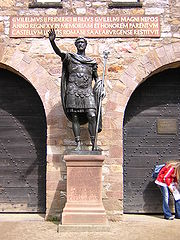
Nassau, Germany
Nassau is a town located in the German Land of Rhineland-Palatinate. It lies in the Lahn River valley between the cities of Bad Ems and Limburg an der Lahn. Nassau is the seat of the Verbandsgemeinde of Nassau. The town is on the German-Dutch holiday road, the Orange Route...
Antiquarian Society under the direction of Friedrich Gustav Habel (1793–1867) . But the great impulse to provincial Roman archaeology
Archaeology
Archaeology, or archeology , is the study of human society, primarily through the recovery and analysis of the material culture and environmental data that they have left behind, which includes artifacts, architecture, biofacts and cultural landscapes...
in Germany came in 1892, when the Reichs-Limes-Kommission (the Imperial Commission for the Roman borders), then chaired by Theodor Mommsen
Theodor Mommsen
Christian Matthias Theodor Mommsen was a German classical scholar, historian, jurist, journalist, politician, archaeologist, and writer generally regarded as the greatest classicist of the 19th century. His work regarding Roman history is still of fundamental importance for contemporary research...
began to research the course of the Limes Germanicus
Limes Germanicus
The Limes Germanicus was a line of frontier fortifications that bounded the ancient Roman provinces of Germania Inferior, Germania Superior and Raetia, dividing the Roman Empire and the unsubdued Germanic tribes from the years 83 to about 260 AD...
in its entirety, as well as the location of all its forts. In the course of this enormous project, not completed for decades, intensive exploration of the Saalburg and its surroundings was pursued by the archaeologists charged with this stretch of the limes, Louis Jacobi (1836–1910) and his son and successor Heinrich Jacobi (1855–1946). In 1897, Kaiser Wilhelm II
William II, German Emperor
Wilhelm II was the last German Emperor and King of Prussia, ruling the German Empire and the Kingdom of Prussia from 15 June 1888 to 9 November 1918. He was a grandson of the British Queen Victoria and related to many monarchs and princes of Europe...
, following a suggestion by L. Jacobi, ordered the reconstruction of the Saalburg fort according to the detailed results of its excavation. As a result, the Saalburg became the most completely reconstructed fort on the entire limes. It also houses the Saalburg Museum, one of the two most important institutions dedicated to the study of the German Limes (the other being the Limesmuseum of Aalen
Aalen
Aalen is a city in the German state of Baden-Württemberg, about east of Stuttgart and north of Ulm. It is the seat of the Ostalbkreis district, and its largest city, as well as the largest city within the Ostwürttemberg region. In spatial planning, Aalen is designated a Mittelzentrum...
). From 1967 to 1993, the museum was directed by the well-known archaeologist Dietwulf Baatz, whose many publications fostered a broad interest in provincial Roman archaeology well beyond specialist circles.
Location
Since prehistoric timesPrehistory
Prehistory is the span of time before recorded history. Prehistory can refer to the period of human existence before the availability of those written records with which recorded history begins. More broadly, it refers to all the time preceding human existence and the invention of writing...
, trade routes like the Lindenweg or Linienweg connected the Rhine-Main plain with the Usingen
Usingen
Usingen is a small town in the Hochtaunuskreis in Hessen, Germany. Until 1972, this residential and school town was the seat of the former district of Usingen.-Location:...
basin, which had been a centre of population since the Neolithic
Neolithic
The Neolithic Age, Era, or Period, or New Stone Age, was a period in the development of human technology, beginning about 9500 BC in some parts of the Middle East, and later in other parts of the world. It is traditionally considered as the last part of the Stone Age...
. Such routes would have followed a course from the mouth of the Nidda
Nidda
Nidda could refer to:*Niddah, a concept in Judaism*Niddah , a tractate in the Mishna and Talmud*Nidda, Hesse, a town in Germany*Nidda , a river in Germany...
near Höchst
Höchst (Frankfurt am Main)
Höchst is a district of Frankfurt am Main, Germany. It is part of the Ortsbezirk West, and is subdivided into 4 Stadtbezirke.Höchst am Main became part of Frankfurt am Main in 1928 together with its boroughs Sindlingen, Unterliederbach and Zeilsheim. It is situated 10 km west of downtown...
, northwards across the low Taunus ridge, as does the modern Bundesstraße
Bundesstraße
Bundesstraße , abbreviated B, is the denotation for German and Austrian national highways.-Germany:...
456. A location along major communication routes almost always equals a strategic importance. Thus, it is no surprise that the mountain pass beside the Saalburg was first fortified by Roman troops during Domitian's
Domitian
Domitian was Roman Emperor from 81 to 96. Domitian was the third and last emperor of the Flavian dynasty.Domitian's youth and early career were largely spent in the shadow of his brother Titus, who gained military renown during the First Jewish-Roman War...
wars against the Chatti
Chatti
The Chatti were an ancient Germanic tribe whose homeland was near the upper Weser. They settled in central and northern Hesse and southern Lower Saxony, along the upper reaches of the Weser River and in the valleys and mountains of the Eder, Fulda and Weser River regions, a district approximately...
(AD 81-96), when two simple earthen enclosures were erected (Schanzen A and B, located between the restored fort and the modern road).
History
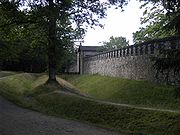
Auxiliaries (Roman military)
Auxiliaries formed the standing non-citizen corps of the Roman army of the Principate , alongside the citizen legions...
consisting of 2 centuria
Centuria
Centuria is a Latin substantive from the stem centum , denoting units consisting of 100 men. It also denotes a Roman unit of land area: 1 centuria = 100 heredia...
s and numbering about 160 men. There is some evidence that the numerus stationed at this fort was a numeros brittonum, i.e. a unit from Britain
Roman Britain
Roman Britain was the part of the island of Great Britain controlled by the Roman Empire from AD 43 until ca. AD 410.The Romans referred to the imperial province as Britannia, which eventually comprised all of the island of Great Britain south of the fluid frontier with Caledonia...
, but this is not entirely clear.
Late in the reign of Hadrian
Hadrian
Hadrian , was Roman Emperor from 117 to 138. He is best known for building Hadrian's Wall, which marked the northern limit of Roman Britain. In Rome, he re-built the Pantheon and constructed the Temple of Venus and Roma. In addition to being emperor, Hadrian was a humanist and was philhellene in...
, c. AD 135, the numerus fort was replaced with a much larger (3.2 hectare) fort for a cohort
Cohort (military unit)
A cohort was the basic tactical unit of a Roman legion following the reforms of Gaius Marius in 107 BC.-Legionary cohort:...
, a unit of about 500 men. The new castle was reoriented to face the growing Roman city of Nida (now Heddernheim). Originally, it had dry-built wood-and stone walls, which were replaced in the 2nd half of the 2nd century with mortared stone walls and an earthen ramp (147 x 221 m). The reconstructed fort is based on that third and last architectural phase, but reminders of the second phase are visible in the retentura (the back of the fort). Part of the second-phase defensive ditch has also been restored and can be inspected there.
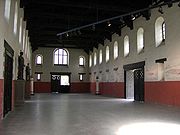
Roman legion
A Roman legion normally indicates the basic ancient Roman army unit recruited specifically from Roman citizens. The organization of legions varied greatly over time but they were typically composed of perhaps 5,000 soldiers, divided into maniples and later into "cohorts"...
headquarters at Mogontiacum (modern Mainz
Mainz
Mainz under the Holy Roman Empire, and previously was a Roman fort city which commanded the west bank of the Rhine and formed part of the northernmost frontier of the Roman Empire...
). The cohort had initially been stationed at Aquae Mattiacorum (Wiesbaden
Wiesbaden
Wiesbaden is a city in southwest Germany and the capital of the federal state of Hesse. It has about 275,400 inhabitants, plus approximately 10,000 United States citizens...
), had then been moved to the Butzbach
Butzbach
Butzbach is a town in the Wetteraukreis district in Hesse, Germany. It is located approx. 16 km south of Gießen and 35 km north of Frankfurt am Main....
fort (ORL 14) and finally to the Saalburg.
The fort existed in that form and with that occupancy until the fall of the German limes in c. AD 260. During the intervening period, the name of the unit is repeatedly mentioned in stone inscriptions, as are the names of some of its commanders.
In the early 3rd century, the situation along the limes became increasingly unsettled. A preventative war under Caracalla
Caracalla
Caracalla , was Roman emperor from 198 to 217. The eldest son of Septimius Severus, he ruled jointly with his younger brother Geta until he murdered the latter in 211...
, who marched against the Alamanni
Alamanni
The Alamanni, Allemanni, or Alemanni were originally an alliance of Germanic tribes located around the upper Rhine river . One of the earliest references to them is the cognomen Alamannicus assumed by Roman Emperor Caracalla, who ruled the Roman Empire from 211 to 217 and claimed thereby to be...
and their Chatti
Chatti
The Chatti were an ancient Germanic tribe whose homeland was near the upper Weser. They settled in central and northern Hesse and southern Lower Saxony, along the upper reaches of the Weser River and in the valleys and mountains of the Eder, Fulda and Weser River regions, a district approximately...
allies from Raetia
Raetia
Raetia was a province of the Roman Empire, named after the Rhaetian people. It was bounded on the west by the country of the Helvetii, on the east by Noricum, on the north by Vindelicia, on the west by Cisalpine Gaul and on south by Venetia et Histria...
and Mogontiacum in AD 213, lowered the Germanic pressure on the border only temporarily. The town of Nida (capital of the regional civitas) was given a defensive enclosure around that time. Already around 233, the Alemanni entered Roman territory again; further major incursions took place in 254 and 260. Eventually, all areas east of the Rhine were lost during the major political and economic crisis of the mid 3rd century. In the course of these events, the Saalburg fort appears to have been abandoned deliberately and without military action.
After the abandonment of the Upper Germanic Limes, the fort was used as a quarry.
Archaeology, architecture
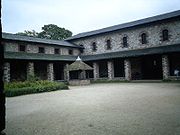
The 3.25 m interior was enclosed by a double ditch and a mortared defensive wall; its external face was whitewashed and painted with a trompe oil pattern of ashlar
Ashlar
Ashlar is prepared stone work of any type of stone. Masonry using such stones laid in parallel courses is known as ashlar masonry, whereas masonry using irregularly shaped stones is known as rubble masonry. Ashlar blocks are rectangular cuboid blocks that are masonry sculpted to have square edges...
blocks. On the inside, an earthen ramp was placed along the length of the wall, to enable defenders to access the top. The corners were rounded and not crowned with towers, but all four gates were flanked by two towers each.
The fort was oriented in such a way that its main gate, or porta praetoria faced south-south-east, that is away from the limes but towards Nida. The central structure of the fort was a large principia, a central plaza surrounded by housing or offices for the higher officers, which was flanked by a roofed hall for assemblies of the fort's garrison. The praetentura (front part of the fort) contained the praetorium (the fort commander's residence) to the west of the via praetoria, and a large horreum (grain store) to its east. The rest of the fort's interior, today a park-like area of grass and trees, should be visualised as packed with further buildings: stables, magazines, workshops and, of course, the actual troop quarters, subdivided into contubernia
Contubernium
The contubernium was the smallest organized unit of soldiers in the Roman Army and was composed of eight legionaries. The men within the contubernium were known as contubernales. Ten contubernia were grouped into a centuria...
. Two such troop barracks have been reconstructed in the southeast part of the fort. For the general arrangement and terminology of Roman fort architecture, see Castra
Castra
The Latin word castra, with its singular castrum, was used by the ancient Romans to mean buildings or plots of land reserved to or constructed for use as a military defensive position. The word appears in both Oscan and Umbrian as well as in Latin. It may have descended from Indo-European to Italic...
.
Vicus
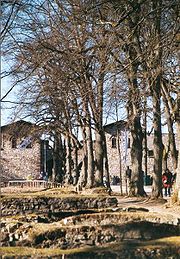
Vicus (Rome)
In ancient Rome, the vicus was a neighborhood. During the Republican era, the four regiones of the city of Rome were subdivided into vici. In the 1st century BC, Augustus reorganized the city for administrative purposes into 14 regions, comprising 265 vici. Each vicus had its own board of...
(adjacent civilian settlement) partially excavated and preserved. The parts of the vicus visible today are located mostly to the south of the fort, on both sides of the road that linked it with Nida, the regional capital and base of further garrison behind the border.
The village begins immediately outside the main gate, where the ruins of a mansio
Mansio
In the Roman Empire, a mansio was an official stopping place on a Roman road, or via, maintained by the central government for the use of officials and those on official business whilst travelling.-Background:The roads which traversed the Ancient World, were later surveyed,...
(an official hostel) and, behind it, of a bath
Thermae
In ancient Rome, thermae and balnea were facilities for bathing...
for the soldiers were found. These are followed along the road by the preserved basements and foundations (partially reconstructed) of residential houses and of - as believed in the time of the excavations - a mithraeum
Mithraeum
A Mithraeum is a place of worship for the followers of the mystery religion of Mithraism.The Mithraeum was either an adapted natural cave or cavern or an artificial building imitating a cavern. Mithraea were dark and windowless, even if they were not actually in a subterranean space or in a natural...
, a shrine to the Mithras, a deity popular among the Roman army .
The fort's bath was relatively large and quite elaborately designed to have all the main features of Roman Thermae
Thermae
In ancient Rome, thermae and balnea were facilities for bathing...
. It has an apodyterium (changing room), a frigidarium (cold bath), two tepidaria (lukewarm baths', a caldarium (hot bath) and a sudatorium (sauna). The complex was heated from the praefurnia (firing places); and all rooms except the apodyterium and frigidarium were served by a hypocaust
Hypocaust
A hypocaust was an ancient Roman system of underfloor heating, used to heat houses with hot air. The word derives from the Ancient Greek hypo meaning "under" and caust-, meaning "burnt"...
system (underfloor and wall heating).
Archaeologists assume that the overall complex (fort and vicus) housed a population of up to 2,000 (500 soldiers, 1,500 civilians).
Saalburg Museum

The most striking features for the modern visitor are the fully reconstructed walls and gates, the principia with its aedes (shrine containing the signa militaria
Aquila (Roman)
The Aquila was the eagle standard of a Roman legion, carried by a special grade legionary known as an Aquilifer. One eagle standard was carried by each legion.-History:...
or standards), the assembly hall, the horreum
Horreum
A horreum was a type of public warehouse used during the ancient Roman period. Although the Latin term is often used to refer to granaries, Roman horrea were used to store many other types of consumables; the giant Horrea Galbae in Rome were used not only to store grain but also olive oil, wine,...
(provisions store), the two barracks buildings with their reconstructed interior contubernia and the partially rebuilt praetorium.
The horreum contains an informative exhibition, focusing on cultural, historical, architectural, and military aspects of Roman Germania
Germania
Germania was the Greek and Roman geographical term for the geographical regions inhabited by mainly by peoples considered to be Germani. It was most often used to refer especially to the east of the Rhine and north of the Danube...
. The museum exhibits a large collection of well preserved military and domestic equipment from the Saalburg and other sites in the area, as well as a series of architectural and terrain models.
Beyond this, the Saalburg has, since its reerection, also functioned as an internationally renowned centre of research, concerned with provincial Roman archaeology in general, and the limes in particular. The heart of this centre is a specialised library of 30,000 volumes and 2,200 slides. The Saalburgmuseum regularly organises colloquia and has its own series of academic publications.
Since the 1980s, the Saalburg is also the venue of occasional Classical concerts.
Surroundings
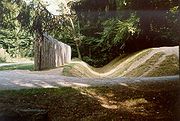
As along most of its extent in the Taunus area, the limes near the Saalburg is remarkably well preserved and can be easily followed through the landscape. Ditch and bank are distinctly visible for long stretches, and many of the former watch towers have been partially preserved or are visible as small mounds. Thus, the Saalburg is a good starting point for further exploration of the limes.
The Saalburg in the context of the local limes between the Kleinkastelle (small forts) of Heidenstock to the southwest and Lochmühle to the northeast:
| ORL | Name | Description/present state |
| KK | Kleinkastell (small fort) Heidenstock | single-gated small stone fort, c. 440 m², probably mid-2nd century AD; walls partially conserved, partially well visible in the ground |
| Wp 3/59 | Roßkopf | 2 clearly visible stone mounds near the eponymous Roßkopf mountain |
| Wp 3/60 | Einsiedel | preserved foundations, remains of a cistern |
| Wp 3/61 | Auf dem Kieshübel | preserved and conserved foundations of 2 stone towers, traces of two wooden towers |
| Wp 3/62 | Am Hollerkopf | scarcely visible remains of a stone tower |
| Wp 3/63 | Weißestein | stone tower mound with partially conserved foundation |
| ORL 11 | Cohort Fort Saalburg | see above |
| Wp 3/68 | Am Fröhlichemannskopf | visible stone tower foundation, barely visible wooden tower location |
| Wp 3/69 | Am Bennerpfad | conserved stone tower foundation |
| KK | Kleinkastell Lochmühle | single-gated, c. 400 m² small stone fort, mid 2nd century AD; visible in terrain |
Near the Saalburg, a copy of the Jupitersäule (a type of painted tall sandstone stele
Stele
A stele , also stela , is a stone or wooden slab, generally taller than it is wide, erected for funerals or commemorative purposes, most usually decorated with the names and titles of the deceased or living — inscribed, carved in relief , or painted onto the slab...
dedicated to Jupiter
Jupiter (mythology)
In ancient Roman religion and myth, Jupiter or Jove is the king of the gods, and the god of the sky and thunder. He is the equivalent of Zeus in the Greek pantheon....
and common in the German provinces) of Mainz has been erected.
Saalburgbahn
The reerection of the fort in the late 19th and early 20th century led to a surge of interest by the local population, including visitors using the spaSpa
The term spa is associated with water treatment which is also known as balneotherapy. Spa towns or spa resorts typically offer various health treatments. The belief in the curative powers of mineral waters goes back to prehistoric times. Such practices have been popular worldwide, but are...
at Bad Homburg
Bad Homburg
Bad Homburg vor der Höhe is the district town of the Hochtaunuskreis, Hesse, Germany, on the southern slope of the Taunus, bordering among others Frankfurt am Main and Oberursel...
. To provide comfortable access, the Bad Homburg tram
Tram
A tram is a passenger rail vehicle which runs on tracks along public urban streets and also sometimes on separate rights of way. It may also run between cities and/or towns , and/or partially grade separated even in the cities...
company constructed a direct rail link, the Saalburgbahn. After a pre-World War I flourish, the company was badly affected by post-war inflation and a massive drop of visitor numbers to the spa. Eventually, the service was closed; scanty traces of its embankment and the (closed) station remain.
Today, the fort can be reached by an hourly bus link from Bad Homburg.
Literature
- Dietwulf Baatz: Saalburg (Taunus). In: Die Römer in Hessen. Nikol, Hamburg 2002, ISBN 3-933203-58-9
- Dietwulf Baatz: Der Römische Limes. Archäologische Ausflüge zwischen Rhein und Donau. Gebr. Mann, Berlin 2000, ISBN 3-7861-2347-0
- Margot Klee: Die Saalburg. Theiss, Stuttgart 1995. (Führer zur hessischen Vor- und Frühgeschichte 5), ISBN 3-8062-1205-8
- Margot Klee: Der Limes zwischen Rhein und Main. Theiss, Stuttgart 1989, ISBN 3-8062-0276-1
- Anne Johnson: Römische Kastelle des 1. und 2. Jahrhunderts n. Chr. in Britannien und in den germanischen Provinzen des Römerreiches. Zabern, Mainz 1987. (Kulturgeschichte der antiken Welt, Vol. 37), ISBN 3-8053-0868-X
- Egon Schallmayer (ed.): Hundert Jahre Saalburg. Vom römischen Grenzposten zum europäischen Museum. Zabern, Mainz 1997, ISBN 3-8053-2359-X
- Heinrich Jacobi: Kastell Nr. 11 Saalburg, Der obergermanisch-raetische Limes des Römerreiches, Series B, Vol. II, Frankfurt 1937 (the original publication of the excavation).
- Since 1910 (with interruptions), a Saalburg Annual (Saalburg Jahrbuch) with scholarly articles on provincial Roman archaeology is published. More than 50 volumes exist.
- Since 1995, theSaalburg-Schriften present archaeological studies to a popular audience.
External links
- Saalburg Museum Website
- Saalburg on the Limes Commission homepage
- Relevant page on German Limes Route page
- Saalburg on a private Limes page
- 3D model of Saalburg]

